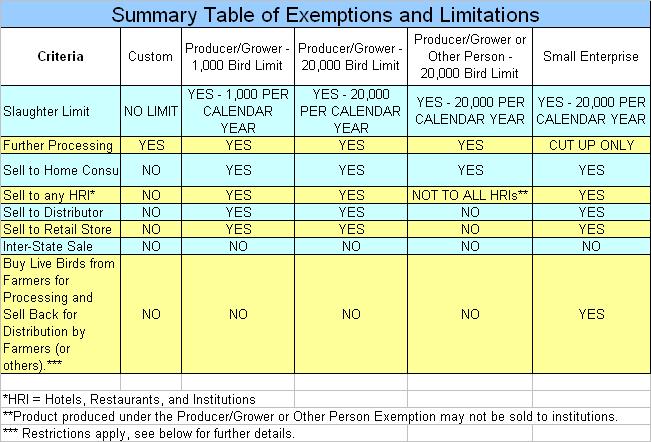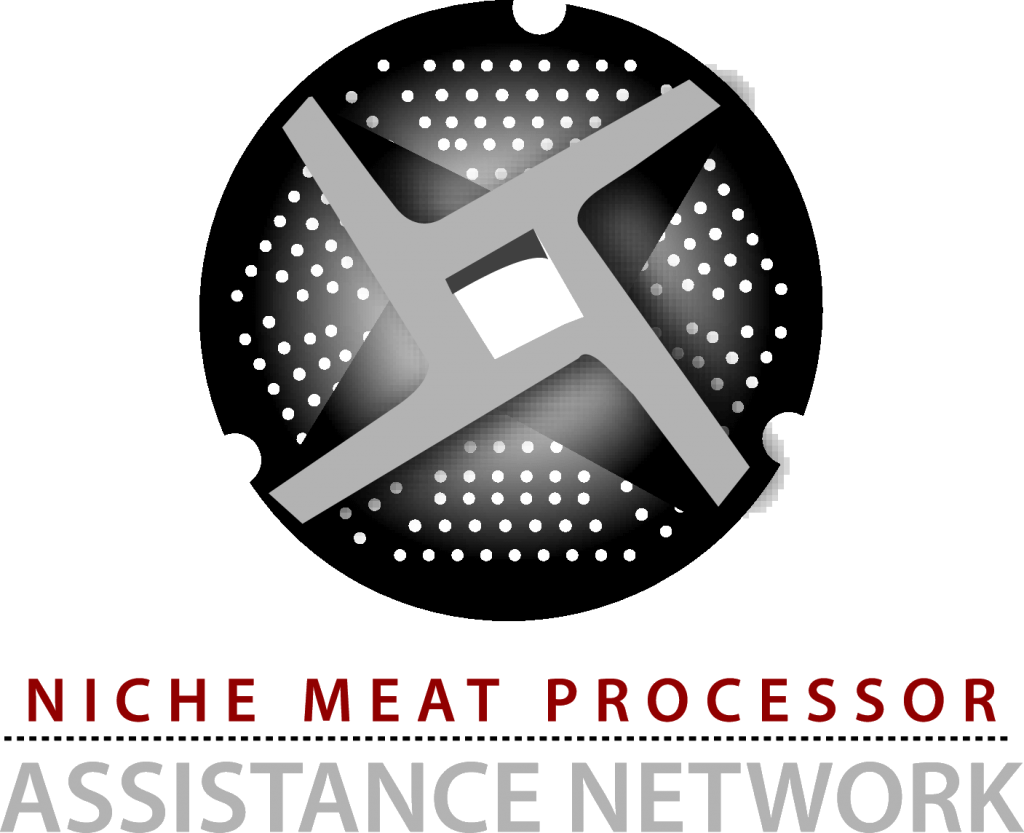This page is not a legal document and should not be considered legal advice.
All poultry exemptions are regulated by Chapter 9, Code of Federal Regulations, Section 381.10 After the Summary table below, we overview the poultry exemptions that allow a producer or processor to slaughter birds and sell them within their state. Other exemptions for personal use only should not be confused with the exemptions discussed in this article.
Summary of Federal Poultry Exemptions
The table below, adapted from the USDA FSIS guidebook, explains which poultry exemptions allow for what kinds of sales.
(Laws by State are discussed at the bottom of this page.)
These exemptions are subject to the cautions listed below. Detailed information on the requirements of all poultry exemptions is available from this guidebook by the Food Safety Inspection Service of the U.S. Department of Agriculture (USDA FSIS): Guidance for Determining Whether a Poultry Slaughter or Processing Operation is Exempt from Inspection Requirements of the Poultry Products Inspection Act. (There are known errors in this guide and a new edition is expected from USDA FSIS in late 2009.)
Of the 5 exemptions in the table above, there are 2 federal exemptions that allow a licensed facility to slaughter and cut-up no more than 20,000 birds per calendar year that can be sold to any consumer, restaurant, institution, or retail outlet (including farmers’ market) within a state that permits the sale of exempt poultry (see cautions below).
1) A person owns their own licensed exempt facility and slaughters their own poultry for sale. Any distributor can distribute poultry processed in the manner. Such poultry products must be labeled with:
1.The name and address of the poultry processor
2.Safe handling instruction that comply with Title 9 CFR 381.125(b)(2)(ii)
3.The statement “Exempted – P.L. 90-492.” This is known as “Producers/Grower Exemption.”
4.Explanatory statement indicating why the requirements inspection legend is not permitted; for example, the phrase “Producer/Growner Exemption from Inspection” is suggested but is not a mandatory requirement.
2) A grower can sell his/her birds to a “Small Enterprise Exempt” processor who slaughters, prepares, and packages the birds (whole and/or cut-up) for retail purchase, and then the producer can buy these same birds back, acting as a distributor, for sale. Or any other distributor can distribute poultry processed in the manner. Poultry products produced under a Small Enterprise Exemption MUST bear all of the features of a label for inspected product with the exception that the labeling does not indicate that the product was inspected and passed. Label requirements for this exempt uninspected product include the following:
1. Name of the product;
2. Ingredients statement;
3. Statement of the quantity of contents in terms of weight or measures;
4. Name and address of manufacturer;
5. Handling statement;
6. Safe handling instruction that comply with Title 9 CFR 381.125(b)(2)(ii)
7. Date of packing; and
8. Explanatory statement indicating why the requirements inspection legend is not permitted; for example, the phrase “Small Enterprise Exemption from Inspection” is suggested by FSIS but is not a mandatory requirement.
CAUTION 1: This information does not apply in all states. These are federal regulations, and a number of states have stricter state regulations governing food sales. The regulations governing how exempt poultry can be sold are in a state’s Food Code, which is typically administered by the state Health Department, not the Agriculture Department or State Meat Inspections of that state.
CAUTION 2: These exemptions are mutually exclusive. A producer/processor may NOT slaughter and process exempt poultry for other producers, even if the facility does not process more than a total of 20,000 birds per calendar year. Additionally, exempt processors may NOT buy or sell poultry products other than his/her own.
CAUTION 3: Anybody planning to build any processing facility, exempt or otherwise, must first prove that they have an adequate potable water source and waste water handling/treatment capacity.
If a state has adopted an FDA model Food Code of any year verbatim or by reference, then producers can retail, wholesale, and distribute as directed by the table above and according to 9 CFR 381.10.
Bottom line: We suggest consulting with your state’s food inspection agency. However, in our experience, there is much confusion around poultry exemptions and you might have to work with your state’s food inspection agency to review the exact Food Code regulatory language of your state to determine what is and is not legal.
NMPAN Guide to Poultry Processing Regulations by State
This downloadable guide provides:
- A summary of state laws and regulations related to poultry processing, with a focus on how (and whether) the federal exemptions work in that state;
- Links to useful state-specific resources, laws and regs, and other online sources as available; and
- Contact info for the relevant agencies.
Last revised August 2012.
Small-Scale Poultry Processing
This document gives a detailed explanation of the poultry processing steps and includes pictures of different parts of the process. On-farm, small, and large processing types are compared to provide information for a variety of audiences in all states. Diagrams of processing equipment and plant setup are included. This document is very informative as it contains facts from other people’s experiences of processing, equipment used, etc.
Developed by Dr. Anne Fanatico.



